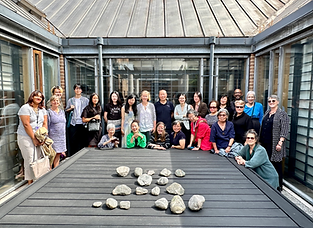
Leilei Qu
Qu Leilei and Caroline Deane, 'The Whole of History Ap[p]ears in Silence.'
Prehistoric/1995/1999.
Found object/installation/conceptual art
courtesy of the artists.

Qu Leilei at 'Sacred Truths: An Interactive Calligraphy Workshop' at SOAS Brunei Gallery, 19 July 2023. Photo by Jiaqi Zhang

'Story of the Stone: Found Calligraphy' exhibition opening, 19 July 2023. Photo by Jiaqi Zhang
Qu Leilei was a founding member of the Stars group in the late 1970s and early 1980s. The avant-garde activities of the Stars group have been recognised as a foundational movement in the history of contemporary Chinese art. Based in London since 1985, Qu Leilei is now one of the world's leading contemporary artists. In recent years he has continuously created art projects that combine painting and installation. His work has been exhibited at venues including the British Museum, the Venice Biennale, the Ashmolean Museum and the Royal Palace in Milan.
Leilei's name in Chinese 磊磊 is literally two piles of stones. The story of the stone can be dated back to 1995 when Qu Leilei and Caroline Deane found a set of stones – whose textures strikingly resemble the 26 letters of the English alphabet – on the Cornish Coast. In 2023, Panpan Yang curated a site-specific exhibition 'The Story of the Stone: Found Calligraphy' at SOAS Brunei Gallery Japanese Roof Garden. Central to this site-specific exhibition or conceptual art project is once again the set of stones, all found in nature, arranged, and re-arranged by Qu Leilei and Caroline Deane. Together the stones articulate this line:
‘Unfit to mend the sky’
無才可去補蒼天
This line is borrowed and translated from a Buddhist verse that appears in the first chapter of the eighteenth-century novel The Story of the Stone (Dream of the Red Chamber), a masterpiece in Chinese literature. It is said that when the goddess Nü Wa melted down stones to mend the sky, she made 36,501 blocks of stones. She used only 36,500 of these. The remaining block of stone, alone rejected, lamented day and night in distress and shame. Jia Baoyu, the male protagonist of the novel, was born with a piece of luminescent jade in his mouth; it was the rejected stone. After generations, the stone had returned to its huge shape, and there was an inscription discernible on it: an account of the stone being rejected, its transformation, its descent into the world of mortals, and all its joys and sorrows. The above-mentioned Buddhist verse was inscribed on the stone’s back.
For the very first time, the stones tell us a story of the stone. As a new member of the family of found objects, the stones present themselves as found calligraphy. If the artists have redefined the stones as contemporary art by changing their utility, their lifespan and their status, the rearrangement of the stones as a reaction to the exhibition space – and the new message that it creates – questions the blurring of the boundary between art creation and curation today.


